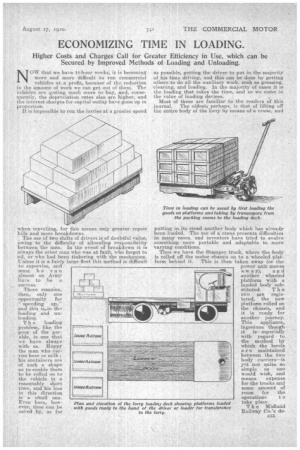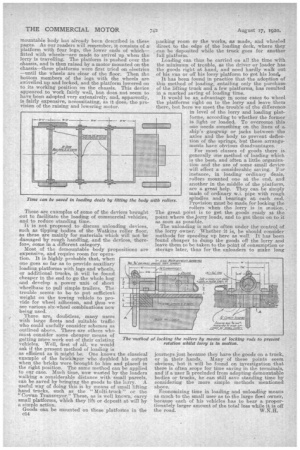ECONOMIZING TIME IN LOADING.
Page 15

Page 16

If you've noticed an error in this article please click here to report it so we can fix it.
Higher Costs and Charges Call for Greater Efficiency in Use, which can be Secured by Improved Methods of Loading and Unloading,
NOW that we have 44-hour weeks, it is becoming more and more difficult to run commercial vehicles at a profit,. because of the reduction in the amount of work we can get out of them. The vehicles are ;.,osting much more to buy, and, consequently, the depreciation rates also are higher, and the interest charges for capital outlay have gone up in proportion. It is impossible to run the lorries at a greater speed
when travelling, for this means only greater repair bills and more breakdowns.
The use of two shifts of drivers is of doubtful value; owing to the difficulty of allocating responsibility between the men. In the event of breakdown it is always the other man who was at fault, who forgot to oil, or who had been tinkering with the mechanism. -Unless it is a fairly large fleet this method is difficult to supervise, and must be run almost on Army lines to be a success.
There remains, then, only are opportunity. for " speeding up," and this iin the loading and unloading.
T h e loading problem, like the poor of the parable, is one that we have always with us. Happy the man who carries beer or milk ; his containers are of such a shape as to enable them to be rolled on to the vehicle in a reasonably short time,_ and his loss in this direction is a shall one. Even here, however, time can be
_ saved by, as far
as possible, getting the driver to put in the majority
of his time driving, and this can be done by getting others to do all the auxiliary work, such as greasing, cleaning, and loading. In the majority of cases it is the loading that takes the time, and so we come •,:o the value of loading devices:
Most of these are familiar to the readers of this journal. The oldest,. perhaps, is that el lifting off the entire body of the lorry by means of a crane, and putting in. its stead another body which has already been loaded. The use of a crane presents difficulties in many cases, •and inventors have tried to evolve something more portable and adaptable to more varying conditions.
Thus we have the Stamper truck, where the body is rolled off the motor chassis on to a wheeled platform behind it. This is then taken away (or the power unit moves a Iv a 3"), and another wheeled platform with a loaded body sub
stituted. T h e two a-re registered, the new platfolim rolled on the chassis, and it is ready for another journey. This applia,nce, ingenious though It is—especially with regard to the method by which the levels
r e maintained between the two body carriers—is yet not quite so simple as one would wish, and means expense for the trucks and some amount of room for the operations t take place.
The Midland Railway Co.'s de
mountable body has already been described in these pages. As our readers will remember, it consists of a platform with four legs, the lower ends of which— fitted with wheels—are made to swivel up when the lorry is travelling. The platform is pushed over the chassis, and is then raised by a motor mounted on the chassis—these platforms were first tried on electrics —until the wheels are clear of the floor. Then the bottom members of the legs with the wheels are swivelled up and locked, and the platform lowered on to its working position on the chassis. This device appeared. to work fairly well, but. does not seem to have been adopted very extensively, and, apparently, is fairly expensive, necessitating, as it does, the provision of the raising and lowering motor.
These are examples of some of the devices brought out to facilitate the loading of commercial vehicles, and to reduce standing time.
It is not proposed todiscuss unloading devices, such as tipping bodies of the Watkins roller floor, as these are mainly for materials which will not be damaged -by rough handling, and the devices, therefore, come in a different category.
Most of the demountable body propositions are expensive, and require room for operation. It is highly probable that, when one goes sofar as to provide auxiliary loading platforms with legs and wheels, or additional trucks, it will be found cheaper in the end to go the whole hog and develop a power unit of short wheelbase to pull simple trailers. The trouble seems to be to put sufficient weight on the towing vehicle to provide for wheel adhesion, and thus we see various six-wheel oombinations now being used.
There are, doubtless, many users with large fleets and suitable traffic who could usefully consider schemes as outlined above. There are others who must consider some cheaper means of getting More work out of their existin vehicles. Well, first of all, we wool ask if the present method of leading is as efficient as it might be. One knows the classical example of the bricklayer who doubled his output when the bricks were brought to him and placed in the right position. The same method can be applied to our case. Much time, now wasted by the loaders walking. a considerable distance with small parcels, can be saved bv bringing:the goods to the lorry. A useful way of doing this is by means of small lifting hand trucks, -such as • -the ' Multi-truck " or the "Cowan Transve3ror." These, as is well known, carry small platforms, which they lift or -deposit at will by a simple action.
Goods can be mounted on these platforms in the c14 packing room or the works, as made, and wheeled direct to the edge of the loading deck, where they can be deposited while the truck goes for another full platform.
Loading can thus be carried on all the time with the minimum of troubles, as the driver or loader has the goods right at hand, and need hardly walk out of his van or off his lorry platform to get his loaf
It has been found in practice that the adoption of this method of loading, entailing only the purchase of the lifting truck and a few platforms, has resulted in a marked saving of loading time. It would be an advantage in some cases to wheel the platforms right on to the lorry and leave them there, but here we meet the trouble of the difference in level of the lorry and loading platforms, according to whether the former is light or loaded-. To overcome this one needs something on the lines of a• ship's gangway or jacks between the axles and the body to prevent deflection of the springs, but these arrangements have obvious disadvantages.
For most classes of goods there is generally one method of loading which is the best, and often a little orga,nizalion and the use of some small device will .effect. a considerable saving. For instance, in loading ordinary deals, rollers mounted one at the end, and another in the middle of the platform, are a great help. They can be simply made of ordinary w.i. pipe with rough spindles and bearings at. each end. Provision must be made for locking the
• rollers when the lorry is in motion. , The great point is to get the goods ready at the point where theJorry loads, and to get them on to it as soon as possible.
The unloading is not so often under the control of the lorry owner. Whether it is, he should consider methods for speeding up here as Well. It has been found cheaper to dump the goods off the lorry and leave them to be taken to the point of consumption or storage later, than for the unloaders to make long journeys just because they have the goods on a truck, or in their hands. Many of these points seem obvious, but it will be found on investigation that there is often scope for time saving in the terminals, and if a user ra precluded from adopting demountable bodies or trucks, he can still save standing time by considering the more simple methods mentioned above.
Economizing time in loading and unloading means as much to the small user as to the large fleet owner, because each of his vehicles has to bear a proportionately larger amount of the total loss while it is off the road. W.N.H.




























